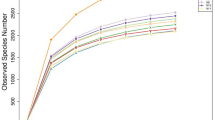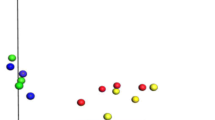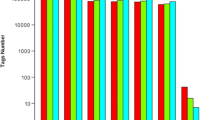Abstract
Although the rumen microbiome of domesticated ruminants has been evaluated, few studies have explored the rumen microbiome of wild ruminants, and no studies have identified the rumen microbiome in the impala (Aepyceros melampus melampus). In the present study, next-generation sequencing and real-time polymerase chain reaction were used to investigate the diversity and density of the bacteria and methanogenic archaea residing in the rumen of five adult male impalas, culled during the winter dry season in Pongola, South Africa. A total of 15,323 bacterial 16S rRNA gene sequences (from five impala), representing 3,892 different phylotypes, were assigned to 1,902 operational taxonomic units (OTUs). A total of 20,124 methanogen 16S rRNA gene sequence reads (from four impala), of which 5,028 were unique, were assigned to 344 OTUs. From the total sequence reads, Bacteroidetes, Proteobacteria, and Firmicutes were the most abundant bacterial phyla. While the majority of the bacterial genera found were unclassified, Prevotella and Cupriavidus were the most abundant classified genera. For methanogens, the genera Methanobrevibacter and Methanosphaera represented 94.3 % and 4.0 % of the classified sequences, respectively. Most notable was the identification of Methanobrevibacter thaueri-like 16S rRNA gene sequence reads in all four impala samples, representing greater than 30 % of each individual’s total sequences. Both data sets are accessible through NCBI’s Sequence Read Archive (SRA), under study accession number SRP [048619]. The densities of bacteria (1.26 × 1010–3.82 × 1010 cells/ml whole rumen contents) and methanogens (4.48 × 108–7.2 × 109 cells/ml of whole rumen contents) from five individual impala were similar to those typically observed in domesticated ruminants.


Similar content being viewed by others
References
Lundrigan B, Sproull K (2000) Aepyceros melampus. In: Anim. Divers. Web. http://animaldiversity.ummz.umich.edu/accounts/Aepyceros_melampus/. Accessed 5 Apr 2013
Vrba ES, Schaller GB (2000) Antelopes, deer, and relatives. Yale University Press, New Haven
Schwab P, Debes PV, Witt T, Hartl GB, Hmwe SS, Zachos FE, Grobler JP (2012) Genetic structure of the common impala (Aepyceros melampus melampus) in South Africa: phylogeography and implications for conservation. J Zool Syst Evol Res 50:76–84
Hill RH (1982) Effect of dietary extremes on impala (Aepyceros melampus). Appl Environ Microbiol 44:198–202
Kingdon J (1997) The Kingdon field guide to African mammals. Academic Press, London
Skinner J, Smithers R (1990) The mammals of the Southern African subregion. University of Pretoria Press, Pretoria
Wright A-DG, Auckland CH, Lynn DH (2007) Molecular diversity of methanogens in feedlot cattle from Ontario and Prince Edward Island, Canada. Appl Environ Microbiol 73:4206–4210
Morgavi DP, Martin C, Jouany J-P, Ranilla MJ (2012) Rumen protozoa and methanogenesis: not a simple cause–effect relationship. Brit J Nutr 107:388–397
Sundset MA, Edwards JE, Cheng YF, Senosiain RS, Fraile MN, Northwood KS, Praesteng KE, Glad T, Mathiesen SD, Wright A-DG (2009) Molecular diversity of the rumen microbiome of Norwegian reindeer on natural summer pasture. Microb Ecol 57:335–348
Sundset MA, Edwards JE, Cheng YF, Senosiain RS, Fraile MN, Northwood KS, Praesteng KE, Glad T, Mathiesen SD, Wright A-DG (2009) Rumen microbial diversity in Svalbard reindeer, with particular emphasis on methanogenic archaea. FEMS Microb Ecol 70:553–562
Ishaq SL, Wright A-D (2012) Insight into the bacterial gut microbiome of the North American moose (Alces alces). BMC Microbiol 12:1471–2180
Huang XD, Tan HY, Long R, Liang JB, Wright A-DG (2012) Comparison of methanogen diversity of yak (Bos grunniens) and cattle (Bos taurus) from the. BMC Microbiol 12:1–10
Gruninger RJ, Sensen CW, McAllister TA, Forster RJ (2014) Diversity of rumen bacteria in Canadian cervids. PLoS ONE 9:1–9
Yu Z, Morrison M (2004) Improved extraction of PCR-quality community DNA from digesta and fecal samples. Biotechniques 36:808–812
Denman S, McSweeney C (2006) Development of a real-time PCR assay for monitoring anaerobic fungal and cellulolytic bacterial populations within the rumen. FEMS Microb Ecol 58:572–582
Denman SE, Tomkins NW, McSweeney CS (2007) Quantitation and diversity analysis of ruminal methanogenic populations in response to the antimethanogenic compound bromochloromethane. FEMS Microb Ecol 62:313–322
Lane DJ (1991) 16S/23S rRNA sequencing. In: Nucleic acid techniques in bacterial systematics. New York, NY, pp 115–175
Turner S, Pryer K, Miao V, Palmer J (1999) Investigating deep phylogenetic relationships among cyanobacteria and plastids by small subunit rRNA sequence analysis. J Eukaryot Microbiol 46:327–338
Schloss PD, Westcott SL, Rayabin T, Hall JR, Hartmann M, Hollister EB, Lesniewski RA, Oakley BB, Parks DH, Robinson CJ, Sahl JW, Stres B, Thallinger GG, Horn DJV, Weber CF (2009) Introducing MOTHUR: open-source, platform-independent, community-supported software for describing and comparing microbial communities. Appl Environ Microbiol 75:7537–7541
Quince C, Lanzén A, Curtis TP, Davenport RJ, Hall N, Head IM, Read LF, Sloan WT (2009) Accurate determination of microbial diversity from 454 pyrosequencing data. Nat Methods 6:639–641
Altschul SF, Gish W, Miller W, Myers EW, Lipman DJ (1990) Basic local alignment search tool. J Mol Biol 215:403–410
Shannon C, Weaver W (1949) The mathematical theory of communication. University of Illinois Press, Urbana
Good I (1953) On population frequencies of species and the estimation of population parameters. Biometrika 40:237–264
King EE, Smith RP, St-Pierre B, Wright A-DG (2011) Differences in the rumen methanogen populations of lactating Jersey and Holstein dairy cows under the same diet regimen. Appl Environ Microbiol 77:5682–5687
Danielsson R, Schnürer A, Arthurson V, Bertilsson J (2012) Methanogenic population and CH4 production in Swedish dairy cows fed different levels of forage. Appl Environ Microbiol 78:6172–6179
St-Pierre B, Wright A-DG (2012) Molecular analysis of methanogenic archaea in the forestomach of the alpaca (Vicugna pacos). BMC Microbiol 12:1–12
Singh KM, Tripathi AK, Pandya PR, Parnerkar S, Kothari RK, Joshi CG (2013) Molecular genetic diversity and quantitation of methanogen in ruminal fluid of buffalo (Bubalus bubalis) fed ration (wheat straw and concentrate mixture diet). Genet Res Int 2013:1–7
An D, Dong X, Dong Z (2005) Prokaryote diversity in the rumen of yak (Bos grunniens) and Jinnan cattle (Bos taurus) estimated by 16S rDNA homology analyses. Anaerobe 11:207–215
Cunha IS, Barreto CC, Costa OYA, Bomfim MA, Castro AP, Kruger RH, Quirino BF (2011) Bacteria and archaea community structure in the rumen microbiome of goats (Capra hircus) from the semiarid region of Brazil. Anaerobe 17:118–124
Pitta DW, Kumar S, Veiccharelli B, Parmar N, Reddy B, Joshi CG (2014) Bacterial diversity associated with feeding dry forage at different dietary concentrations in the rumen contents of Mehshana buffalo (Bubalus bubalis) using 16S pyrotags. Anaerobe 25:31–41
Ishaq SL, Wright A-DG (2014) High-throughput DNA sequencing of the ruminal bacteria from moose (Alces alces) in Vermont, Alaska, and Norway. Microb Ecol 1–11
Kos M, Hoetmer AJ, Pretorius Y, Boer WF, Knegt H, Grant CC, Kohi E, Page B, Peel M, Slotow R, Waal C, Wieren SE, Prins HHT, Langevelde F (2011) Seasonal diet changes in elephant and impala in mopane woodland. Eur J Wildl Res 58:279–287
Kim M, Morrison M, Yu Z (2011) Status of the phylogenetic diversity census of ruminal microbiomes. FEMS Microb Ecol 76:49–63
Li ZP, Liu HL, Li GY, Bao K, Wang KY, Xu C, Yang YF, Yang FH, Wright A-DG (2013) Molecular diversity of rumen bacterial communities from tannin-rich and fiber-rich forage fed domestic Sika deer (Cervus nippon) in China. BMC Microbiol 13:1–12
Fernando S, Purvis H, Najar F, Sukharnikov L, Krehbiel C, Nagaraja T, Roe B (2010) Rumen microbial population dynamics during adaptation to a high-grain diet. Appl Environ Microbiol 76:7482–7490
Hook S, Steele M, Northwood K (2011) Impact of subacute ruminal acidosis (SARA) adaptation and recovery on the density and diversity of bacteria in the rumen of dairy cows. FEMS Microb Ecol 275–284
Das KC, Paul SS, Sahoo L, Baruah KK, Subudhi PK, Ltu KRC (2014) Bacterial diversity in the rumen of mithun (Bos frontalis) fed on mixed tree leaves and rice straw based diet. Afr J Microbiol Res 8:1426–1433
Samsudin AA, Evans PN, Wright A-DG, Al Jassim R (2011) Molecular diversity of the foregut bacteria community in the dromedary camel (Camelus dromedarius). Env Microbiol 13:3024–3035
Makkar NS, Casipa LE (1987) Cupriavidus necator gen. nov., sp. nov. A nonobligate bacterial predator of bacteria in soil. Int J Syst Bacteriol 37:323–326
Booyse D, Dehority BA (2011) Protozoa and digestive tract parameters of the impala. Onderstepoort J Vet Res 78:1–5
Franzolin R, St-Pierre B, Northwood K, Wright A-DG (2012) Analysis of rumen methanogen diversity in water buffaloes (Bubalus bubalis) under three different diets. Microb Ecol 64:131–139
Wright A-DG, Ma X, Obispo NE (2008) Methanobrevibacter phylotypes are the dominant methanogens in sheep from Venezuela. Microb Ecol 56:390–394
Wright A-DG, Williams AJ, Winder B, Christophersen CT, Rodgers SL, Smith KD (2004) Molecular diversity of rumen methanogens from sheep in Western Australia. Appl Environ Microbiol 70:1263–1270
Wright A-DG, Northwood KS, Obispo NE (2009) Rumen-like methanogens identified from the crop of the folivorous South American bird, the hoatzin (Opisthocomus hoazin). ISME J 3:1120–1126
Popova M, Morgavi DP, Martin C (2013) Methanogens and methanogenesis in the rumens and ceca of lambs fed two different high-grain-content diets. Appl Environ Microbiol 79:1777–1786
Miller TL, Lin C (2002) Description of Methanobrevibacter gottschalkii sp. nov., Methanobrevibacter thaueri sp. nov., Methanobrevibacter woesei, Methanobrevibacter wolinii. Int J Sys Evol Microbiol 52:819–822
Williams YJ, Popovski S, Rea SM, Skillman LC, Toovey AF, Northwood KS, Wright A-DG (2009) A vaccine against rumen methanogens can alter the composition of archaeal populations. Appl Environ Microbiol 75:1860–1866
Facey HV, Northwood KS, Wright A-DG (2012) Molecular diversity of methanogens in fecal samples from captive Sumatran orangutans (Pongo abelii). Am J Primat 74:408–413
Acknowledgments
We thank Suzanne Ishaq and Rachel Smith for their assistance in the laboratory.
Author information
Authors and Affiliations
Corresponding author
Rights and permissions
About this article
Cite this article
Cersosimo, L.M., Lachance, H., St-Pierre, B. et al. Examination of the Rumen Bacteria and Methanogenic Archaea of Wild Impalas (Aepyceros melampus melampus) from Pongola, South Africa. Microb Ecol 69, 577–585 (2015). https://doi.org/10.1007/s00248-014-0521-3
Received:
Accepted:
Published:
Issue Date:
DOI: https://doi.org/10.1007/s00248-014-0521-3




